Kenya occupies a strategic position along the eastern coastline of Africa, lying directly on one of the world’s busiest international shipping lanes. At any given moment, approximately fifty vessels navigate these waters, ranging from container ships and bulk carriers to specialized tankers. Notably, around ten of these are oil tankers transporting crude oil from the resource-rich Middle East, with displacements varying between 50,000 and 250,000 metric tons. This heavy maritime traffic underscores the critical importance of Kenya’s maritime domain to global trade.
Stretching over 600 kilometers from Tanzania in the south to Somalia in the north, Kenya’s coastline has been a nexus of maritime activity for centuries. Dating back to the 5th century, ancient ports such as Lamu, Malindi, and Mombasa served as key hubs where Chinese armadas, Ottoman fleets, and Portuguese vessels docked for trade and resupply. These historical interactions have not only shaped Kenya’s cultural heritage but also established its longstanding significance in maritime affairs.
Beyond its coastline, Kenya is endowed with numerous inland water bodies that are vital for regional trade and transportation. The expansive Lake Victoria—the largest lake in Africa—and Lake Turkana are prominent examples, alongside smaller lakes scattered throughout the Rift Valley and coastal regions. These waterways facilitate commerce, support livelihoods, and contribute to the nation’s socioeconomic development.
The health of Kenya’s maritime and aquatic environments is intrinsically linked to its economic prosperity. Tourism, a major source of foreign exchange, thrives on the country’s pristine beaches, coral reefs, and diverse marine ecosystems. Similarly, fisheries are essential for trade and subsistence, providing food security and employment for a significant portion of the population. However, these resources face threats from environmental disasters, pollution, and unsustainable human activities that can lead to degradation and long-term harm.
The Port of Mombasa stands as a linchpin in the region’s economic infrastructure. Serving not only Kenya but also landlocked nations such as Uganda, the Democratic Republic of Congo, Rwanda, Burundi, and South Sudan, the port is a critical gateway to international markets. Ethiopia and Somalia also utilize this vital facility to some extent. Goods destined for these countries traverse the “Northern Corridor,” highlighting the importance of secure and efficient maritime operations for regional trade and integration.
In recognition of the need to safeguard its maritime interests, Kenya established the Kenya Maritime Authority (KMA). The Authority is tasked with regulating, coordinating, and overseeing maritime affairs to ensure safe navigation, promote maritime security, and prevent marine pollution. By implementing robust regulatory mechanisms, the KMA aims to protect the maritime environment from adverse impacts such as oil spills, illegal dumping, and overfishing.
The authority also focuses on enhancing Kenya’s maritime capacity by promoting sustainable use of marine resources and supporting the growth of the maritime economy. Through policy development, stakeholder engagement, and international cooperation, the KMA plays a pivotal role in advancing Kenya’s position as a responsible maritime nation committed to environmental stewardship and economic development.
In an era where maritime domains are increasingly important for global trade and environmental sustainability, Kenya Maritime Authority stands at the forefront of ensuring that Kenya’s waters are protected, utilized responsibly, and contribute positively to the nation’s prosperity and that of the broader East African region.
